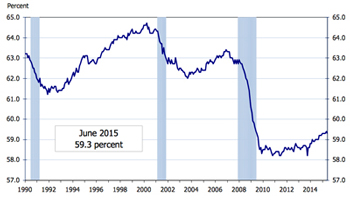

Vol. 79/No. 25 July 20, 2015

|
| Percent of working-age population who are employed fell from 63.3 percent in January 2007 to 59.4 percent at end of recession in June 2009, and has not risen above that figure since. |
But these statistics mask a harsh reality: six years into the recovery, millions of workers are jobless, especially in mining, steel, oil and other basic industries, and many of the new jobs that have come online are part time, temporary or relatively low paid.
Orders for manufactured goods dropped 1 percent in May, the ninth decline over the last 10 months, reported the Commerce Department.
Mine bosses axed 4,000 jobs in June, bringing to 71,000 the number of mine jobs cuts since December. At the end of May, Murray Energy told 1,417 workers at five West Virginia mines their jobs were being eliminated. Almost 250 were cut in Ohio and 162 in Illinois. St. Louis-based Patriot Coal filed for bankruptcy for the second time in three years in May.
At the end of April, U.S. Steel issued layoff warnings to 9,000 of its 35,000 workers. The bosses have cut back operations at eight mills, idled the East Chicago Tin mill and permanently shut down the coke plant at Gary Works.
With oil prices plummeting, job cuts worldwide are estimated at some 150,000, energy recruiting firm Swift Worldwide Resources said in June, with the U.S. seeing “the fastest and steepest decline.” Schlumberger, Halliburton, Baker Hughes and Weatherford, the world’s four biggest oil-tool manufacturers, have announced plans to slash nearly 50,000 jobs.
BNSF Railway, the biggest carrier in the North Dakota Bakken shale region, hauling most of the more than 1.1 million barrels of oil that had been flowing out of the region daily, said in May it is planning to furlough workers because of falling demand.
Trinity Industries in Texas, which manufactures rail cars, has run through two rounds of layoffs, shedding 450 of its 1,150 workers.
According to the Labor Department, 223,000 jobs were added overall in June. But the department revised its figures for April and May downward, saying that 60,000 fewer jobs were created than previously reported.
At the same time, government statisticians removed 432,000 people from the workforce, saying they were no longer looking for work. This brought “labor participation” — those working or classified as officially unemployed and actively looking for work — to a 38-year low of 62.6 percent of the civilian working-age population.
While official jobless rates have dropped from nearly 10 percent in 2010 to 5.3 percent today, some 6.5 million people who are only able to get part-time hours are counted as employed. On top of the 8.3 million workers classified as unemployed, there are 1.9 million more who have been out of work for less than 12 months, but haven’t looked for work over the past four weeks, who the government doesn’t include as part of the labor force. The millions who haven’t looked for work in over a year don’t count either.
The percentage of the working-age population with a job, a more objective way of viewing what is happening than the unemployment rate, dropped from 63.3 percent in January 2007 to 59.4 percent in June 2009 when the recession officially ended. Over the past six years it has not risen above this figure. Last month it was 59.3 percent.
The Labor Department reported some 95,000 jobs were created last month in retail, health care and leisure and hospitality. The expanding fight for $15 an hour has pressured some employers, including McDonald’s, Walmart and Target, to raise pay rates for some workers, but overall real wages remain stagnant.
The crisis for workers’ jobs and wages is part of the long-term worldwide decline in capitalist production and trade. Instead of investing in plants and production, bosses seek a higher rate of return through speculation on stocks, bonds, derivatives and other financial bets, a course they can’t avoid but that inevitably leads to more economic instability, explosive bubbles and financial crisis.
Front page (for this issue) | Home | Text-version home